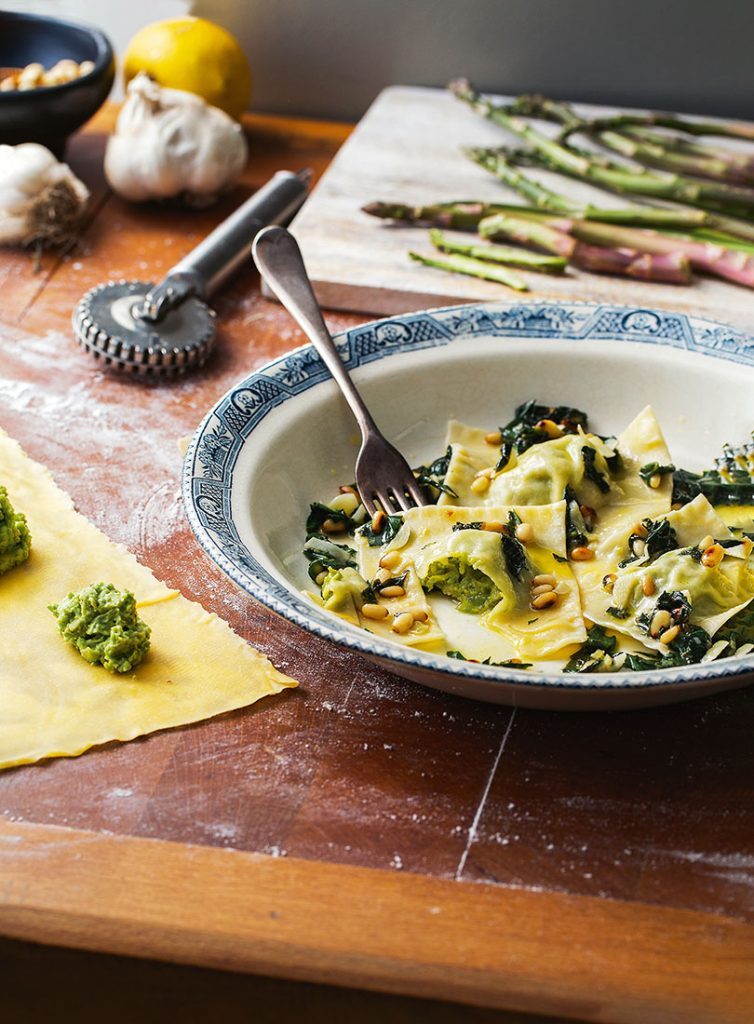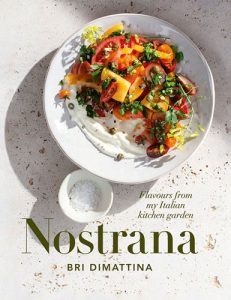Asparagus & Lemon Ricotta Ravioli
Bri DiMattina

Serves
4Ingredients
| RAVIOLI | |
| pasta dough (see recipe), or use wonton wrappers (see note) | |
| 2 cups chopped asparagus | |
| 1 cup (120g) peas | |
| 1 cup (240g) ricotta (see recipe) | |
| ½ cup (40g) grated parmesan | |
| 1 teaspoon finely grated lemon zest | |
| GARLIC BUTTER SAUCE | |
| 75g butter | |
| ⅓ cup (50g) pinenuts | |
| 2 garlic cloves, finely chopped | |
| ½ cup chopped perpetual spinach | |
| lemon juice, to taste | |
| fresh watercress or rocket, to serve | |
| PASTA serves 6 | |
| 4 cups (600g) '00' flour | |
| 5 eggs | |
| ½ tablespoon olive oil | |
| FRESH RICOTTA makes about 200g | |
| 2 cups (500ml) full cream milk (not homogenised) | |
| 200ml cream | |
| pinch of sea salt (must be non-iodised) | |
| 20ml fresh lemon juice |
NOTE
I always keep wonton wrappers on hand to make quick ravioli, without having to bust out the pasta-making gear.
This is such a ‘beginning of spring’ dish for me. The asparagus spears pop up in the garden a few at a time, so this recipe makes them go a little further. The milk I make the ricotta with starts to become a little richer and creamier, so this is a very representative dish of early spring.
View the recipe collection here
Instructions
| 1. | Make the pasta dough, following the recipe given here. |
| 2. | While the dough rests, make the filling. Cook the asparagus and peas in salted boiling water for 3–4 minutes, until tender. |
| 3. | Drain well then purée to your preferred consistency – I like a little texture. |
| 4. | Set aside to cool, then mix in the ricotta, parmesan and lemon zest. Season with salt and pepper to taste. |
| 5. | Cut dough into 8 pieces. Roll dough through the pasta machine, following the recipe and finishing on the third- or second-last setting, until you have 8 long, thin sheets. |
| 6. | Place heaped teaspoons of filling along the length of one sheet, leaving about 4cm between mounds and from the edge of the dough. |
| 7. | Gently drape a second sheet of dough over the top and press around each mound, removing any air pockets as you go. Repeat with remaining dough and filling. |
| 8. | Cut each ravioli into squares and place on a lightly floured (or baking paper-lined) tray. |
| 9. | For the sauce, heat the butter in a large frying pan until it foams, add the pinenuts and cook until golden. |
| 10. | Add the garlic and cook, stirring, until soft and lightly golden. |
| 11. | Add the spinach and a squeeze of lemon juice. |
| 12. | Remove from the heat and set aside until the ravioli is ready. |
| 13. | Bring a large pot of salted water to the boil, then reduce to a simmer. |
| 14. | Cook the ravioli in batches for 2–3 minutes, until tender. |
| 15. | Reheat the sauce. Use a slotted spoon to transfer the ravioli to the sauce. |
| 16. | Serve with fresh watercress or rocket. |
| 17. | PASTA |
| 18. | Place the flour into a mound on the bench and make a well in the centre. |
| 19. | Add the eggs and the olive oil. Using a fork (or by hand) slowly start to mix the eggs and the oil, incorporating the flour on the inside of the mound as you go. The dough will slowly start to come together. |
| 20. | Once the flour has all been incorporated, start kneading the dough with the heel of your hand. |
| 21. | If it is sticky, add a little flour to the bench and continue to knead for a good 10 minutes. The dough should be soft, elastic and just a little sticky. |
| 22. | Cover with a damp cloth and let it rest for 30 minutes. |
| 23. | Cut the dough into 8 pieces. Shape 1 piece into a rough rectangular shape and dust generously with flour. |
| 24. | Starting on the widest setting of the rollers on the pasta machine, feed the dough through. |
| 25. | Fold into thirds and feed it through again the other way (starting at the shortest side). Do this a couple of times, dusting with flour as necessary. |
| 26. | Change to the next setting on the pasta machine, and roll the dough through. Change to the next setting and roll again, without folding. |
| 27. | Keep rolling, reducing the setting each time and finishing at your desired thickness (it will depend on how you are going to use the pasta). |
| 28. | Repeat with the remaining dough and cut into desired shapes. |
| 29. | FRESH RICOTTA |
| 30. | Combine the milk, cream and salt in a heavy-based saucepan over low heat. |
| 31. | Place a candy thermometer into the pan. Heat slowly, stirring gently just occasionally. (If you like, use a double boiler, which will ensure that the mixture heats slowly.) |
| 32. | When the temperature reaches 80°C remove pan from the heat and add the lemon juice. I always add just a little at a time and swirl it in gently before I add a little more. |
| 33. | Just as you see the mixture start to separate, stop adding juice and let it sit for a while. |
| 34. | The amount of lemon juice needed can vary, depending on the milk, so as long as you are adding just a little at a time it will be fine. |
| 35. | Place a colander over a bowl, and line the colander with cheesecloth or muslin. Pour the mixture into the colander and set aside for about an hour to drain naturally (don’t press or squeeze it). |
| 36. | You could also put it in the fridge overnight if you would like a drier curd. |
| 37. | The solid part is the curd (the ricotta cheese), and the liquid is the whey. Keep in the fridge until needed. |
 This is an edited
This is an edited
extract from Nostrana
by Bri DiMattina,
published by
Harper Collins,
photography by
Lottie Hedley, $55.
